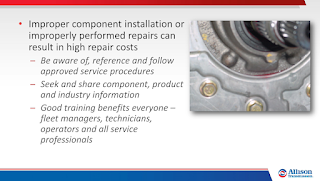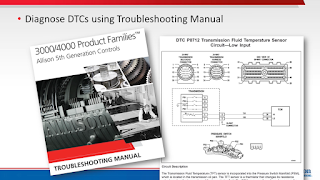Allison 3000/4000 Product Families - Service Issues and Diagnostics
Service Issues and Diagnostics - Fleets
A). Fluid and Filter Change Intervals
Extending fluid and filter change intervals beyond Allison
recommendations and requirements can cause a variety of Transmission issues.
- Old, dirty fluid can lead to overheating, which can diminish clutch
life and harm rotating components.
- Extended service intervals may allow dirt and debris to affect valve
movement, affecting operation and generating diagnostic codes.
- To prevent these issues, proper preventive maintenance and a clean
work environment are essential.
B). Restricted Air Flow
Restricting air flow to the Transmission can increase Transmission temperature and decrease Transmission cooling capacity.
- This can also diminish transmission fluid life.
Extended idling in range can also cause overheating.
- Proper driver training can help prevent this – drivers should
understand that Neutral should be selected whenever the vehicle will be
stopped with the Engine idling for extended periods of time.
C). Technician Errors
Improper component installation or improperly performed
repairs can result in high repair costs.
- Be aware of, reference and follow approved service procedures.
- Seek and share component, product and industry information.
- Good training benefits everyone – fleet managers, technicians,
operators and all service professionals.
D). Improper Towing
Never tow Allison-equipped vehicles with the drive wheels
on the ground.
- Always disconnect the drive line or lift the drive wheels off the
ground when towing.
- The Engine must be running to operate the Transmission pump, which sends
lube to the rotating components.
- Severe damage results from improper towing due to a lack of lube.
E). Driveline Issues
An improperly designed or poorly maintained driveline can
cause drivability issues and Transmission damage.
- Operator complaints may include vibration, noise or poor shift
quality.
- Transmission damage can occur to carrier components, bearings,
clutches and more.
The Transmission is often mis-diagnosed as the root cause
of failure or issues.
- Check U-joint, slip joint, slip joint spline and installation
hardware condition.
- Check Transmission output yoke or flange condition and installation.
- Look for damaged or dented driveshafts and indication of missing
shaft balance weights.
- Check wheels and tires for damage or imbalance issues.
- Check for axle, axle bearing or wheel bearing issues.
F). Diagnostics
Some basic diagnostic steps apply when troubleshooting any
Allison Transmission.
- Check the Transmission fluid level and condition.
- Visually inspect the Transmission for physical damage and leaks.
- Inspect the Transmission Electronic Control system wiring harness
and connectors for damage.
- Check all vehicle systems for obvious damage and problems –
performance issues which may seem related to the Transmission are
sometimes caused by other vehicle systems.
Have available and understand how to use the
Troubleshooting Manual applicable to the installed Transmission Electronic
Control system.
- Separate manuals are available for the different Electronic Control
systems, from legacy WTEC controls to the latest Generation Controls
version.
- Recognize the installed Electronic Control system and reference the
appropriate Troubleshooting Manual.
Use Allison DOC® to gather basic diagnostic information.
- Check for DTCs.
- Verify the TCM is receiving proper voltage.
- Verify the TCM is recognizing appropriate input, turbine and output
speed signals.
If DTCs are logged:
- Write down the DTCs.
- Save the DTC Failure Records if available, use this data to
determine the attained Transmission range and vehicle operating variables that
existed when the DTC was set.
- Use the Troubleshooting Manual to understand the general conditions
causing the DTCs.
- If it makes sense for the situation, attempt to clear the DTCs and
operate the vehicle.
- If cleared DTCs reset, the issues still exist and must be diagnosed
following the detailed procedures in the Troubleshooting Manual.
























0 Response to "Allison 3000/4000 Product Families - Service Issues and Diagnostics"
Post a Comment